Estimated reading time: 19 minutes
Introduction
Adding a drip to a sprinkler system is a smart choice for those looking to save water and ensure their garden’s health. With valves, poly pipes, drip heads, and adapters, you can transition from a conventional system to one that directs water right to the plant roots. By incorporating risers and adjustable outlets with the proper thread, you can weave poly tubing into your existing layout, crafting a manifold setup that’s both efficient and practical.
By employing barbed drippers, elbows, and dripper inserts alongside the usual spray heads, your garden’s every area gets just the right moisture level. Hooking these up to your faucet or sprayer via an adapter enables an irrigation scheme that’s customizable and suited to your landscape’s specific requirements. This approach not only conserves water by reducing evaporation and runoff but also supports healthier plant life by avoiding the pitfalls of excessive watering. When contemplating an upgrade to your garden’s watering system, the act of integrating a drip system with your sprinkler network stands out as a move that benefits your green space, your budget, and the planet.
Key Takeaways
- Adding drip irrigation to your sprinkler system can conserve water and reduce watering costs.
- Drip irrigation helps prevent fungus and disease growth and protects against soil nutrient leaching and erosion.
- A DIY installation of a drip system can enhance the efficiency of your lawn’s irrigation.
- Consider the benefits of drip irrigation before upgrading your sprinkler system.
- Save water and promote a healthier, vibrant landscape with drip irrigation.
The Benefits of Drip Irrigation
Switching from conventional watering to drip irrigation highlights the effectiveness of specifically targeting plant hydration, especially when you aim to convert a sprinkler to a more water-conservative system. At sprinkler school, the emphasis is on the judicious use of water, ensuring drip line and drip irrigation tubing are strategically placed to directly benefit plant roots, thereby avoiding unnecessary water loss. Ensuring a secure attachment with a swivel adapter and clamp to the hose end or drip irrigation pipe into your PVC system is crucial. This method, outlined in everything you need to know, revolutionizes traditional irrigation methods, underlining the importance of conducting a test the system to confirm no lot of water is wasted. Incorporating a washer and conducting a flush of the system prior to use enhances its efficiency and longevity. Adopting drip irrigation is a step towards conserving water and promoting garden vitality.
Essential steps for transitioning to a drip irrigation system include:
- Step 1: Mapping out your system, focusing on drip line placement for optimal water use.
- Step 2: Laying down drip irrigation tubing to accurately direct water to plant roots.
- Step 3: Connecting securely using a swivel adapter and clamp, integrating hose end fittings or drip irrigation pipe with your PVC infrastructure.
- Step 4: Conducting a test the system to ensure its effectiveness and that no lot of water is wasted, implementing a washer and flush before full deployment.
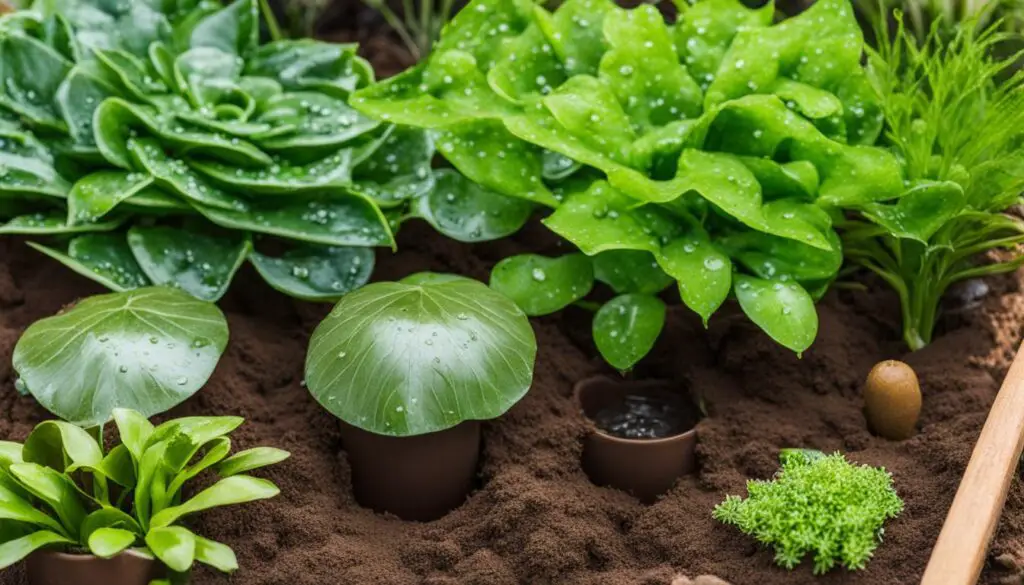
Comparison of Drip Irrigation and Traditional Sprinkler Systems
| Aspect | Drip Irrigation | Traditional Sprinkler System |
|---|---|---|
| Watering Efficiency | Highly efficient with precise water placement | Less efficient with potential water runoff and evaporation |
| Water Conservation | Minimizes water loss and promotes water conservation | May result in water wastage due to runoff and evaporation |
| Plant Health | Prevents under watering and over watering, promoting healthier plants | May lead to under watering or over watering, affecting plant health |
| Cost | Initial setup costs may be higher but can lead to long-term water savings | Lower initial costs but potentially higher water bills |
Getting Started with Drip Irrigation
Initiating drip irrigation effectively cuts down on water is wasted in evaporation, ensuring water right to the roots. This approach uses much water more efficiently, leading to a reduction in weed growth by precisely targeting water delivery. The setup includes a mainline, which acts as the system’s connection point, and drip tubing measured to the desired length to reach the end of the tubing at the correct ground level.
Securing connections is key, involving the attachment of the barbed end into the dual outlet or employing a coupler for necessary adjustments. It’s important to check to see if there’s any leakage and unscrew parts for any needed tweaks. Placing an end cap at the tubing’s terminus ensures no water escapes unnecessarily. Properly positioning the tubing at or just beneath ground level helps conserve less water and keeps your garden orderly. Components like the barb and coupler are readily obtainable at your local hardware store. To safeguard the system and maintain garden aesthetics, bury the tubing within a trench.
To give you a better idea of what a typical drip irrigation kit may include, here’s an example:
| Component | Quantity | Description |
|---|---|---|
| Drip Emitters | 20 | Individual emitters that deliver water directly to the plant roots. |
| Tubing | 50 feet | Flexible plastic tubing that carries water from the source to the emitters. |
| Timers | 1 | Automated device that controls the watering schedule. |
| Connectors | Various | Accessories used to connect different parts of the drip system. |
Once you have your kit, the next step is installation. It’s important to plan your layout and measure the areas that need irrigation. Start by connecting the drip tubing to your existing water source, such as a hose bib or irrigation line. Then, position the emitters near the plants, ensuring they are evenly spaced and placed close to the roots.
After the installation, regularly inspect and maintain your drip system to ensure optimal performance. Check for clogged emitters, leaks, or any signs of damage. Adjust the watering schedule based on the needs of your plants and the weather conditions. With proper care and maintenance, your drip irrigation system will provide efficient and precise watering for your garden.
Considering Soil Types for Drip Irrigation
When it comes to drip irrigation, understanding the soil types in your garden is crucial for optimal watering. Different soils have varying properties that affect water absorption and distribution. By selecting the right emitters for your soil type, you can ensure that your plants receive the appropriate water for healthy growth.
There are three main types of soil: clay soil, loam soil, and sandy soil. Each type has its characteristics and requires specific considerations for drip irrigation.
Clay Soil
Clay soil is known for its fine particles, which can result in poor water drainage and compaction. When irrigating with drip systems, it is important to use low-flow emitters that deliver water slowly. This ensures that water penetrates the soil efficiently without causing waterlogging or runoff. By providing a steady water supply, you can help clay soil retain moisture and improve plant root development.
Loam Soil
Loam soil is a well-balanced soil type that consists of a mixture of sand, silt, and clay particles. It has good water retention and drainage properties, making it suitable for a wide range of plants. With loam soil, medium-flow emitters are generally recommended. These emitters distribute water evenly throughout the soil, providing the right amount of moisture for plants to thrive.
Sandy Soil
Sandy soil is composed of larger particles and drains quickly. It can be challenging to maintain adequate moisture levels in sandy soil. To address this, higher GPH (gallons per hour) emitters or mini-sprayers are typically used for drip irrigation. These emitters compensate for the fast water absorption of sandy soil, ensuring that plants receive enough water for healthy growth.
| Soil Type | Recommended Emitters |
|---|---|
| Clay Soil | Low-flow emitters |
| Loam Soil | Medium-flow emitters |
| Sandy Soil | Higher GPH emitters or mini-sprayers |
By considering the soil type in your garden, you can make informed decisions about the emitters to use in your drip irrigation system. This will ensure that your plants receive the right amount of water and promote efficient water usage. Understanding the unique characteristics of your soil is essential for successful drip irrigation and healthy plant growth.

Choosing the Right Timer for Your Drip System
When maximizing the efficiency of your drip irrigation system, having the right timer is crucial. Timers, also known as irrigation controllers, are responsible for automating the watering schedule, ensuring that your plants receive the right amount of water at the right time. With a variety of options available, it’s important to choose a timer that suits your specific needs and preferences.
“Having a timer for your drip system not only saves you time and effort but also helps in water conservation.”
For smaller home gardens, battery timers are commonly used. These timers are easy to install and program, making them a convenient choice for DIY enthusiasts. However, for those seeking more advanced features and the ability to operate in multiple areas, high-end battery timers are worth considering. These timers often come with programmable schedules and the capability to control multiple zones.
Table: Comparison of Timer Types
| Timer Type | Features | Recommended Use |
|---|---|---|
| Battery Timers | Easy to install and program Suitable for smaller gardens |
Home gardens, small landscapes |
| High-End Battery Timers | Advanced features Control of multiple zones |
Medium-sized to large gardens |
| Electronic Timers | Multiple programs Control of multiple zones |
Commercial landscapes, large gardens |
| Solar Timers | Eco-friendly option Uses solar power |
Environmentally conscious individuals |
Another option to consider is electronic timers. These timers can create programs and control multiple zones, making them ideal for commercial landscapes or larger gardens. They provide flexibility in scheduling and allow for precise control over the watering duration and frequency.
If you’re looking for an eco-friendly option, solar timers are a great choice. Powered by solar energy, they eliminate the need for batteries or electricity and reduce your carbon footprint. These timers are perfect for environmentally conscious individuals who want to minimize their environmental impact.
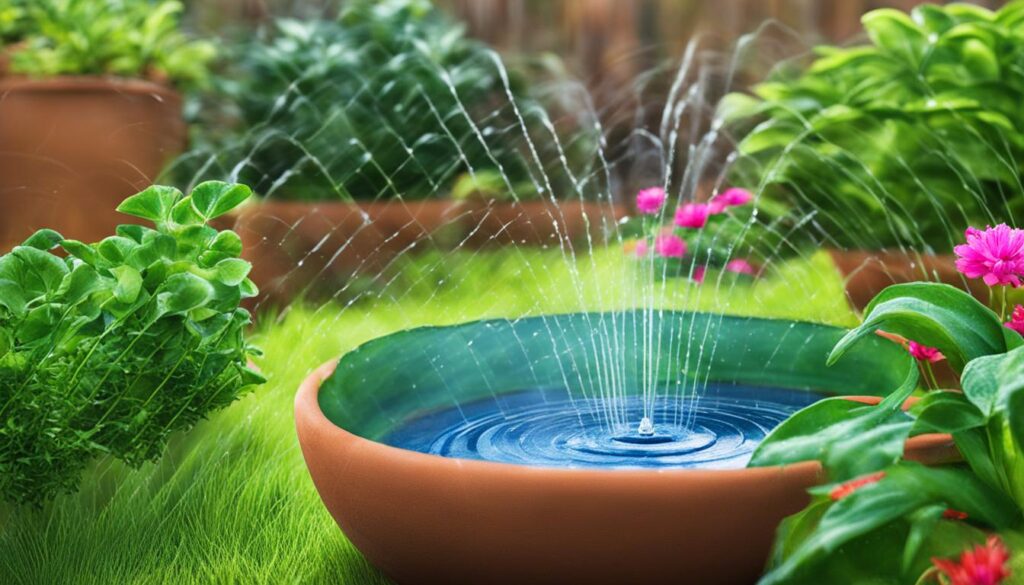
“Choose a timer based on your specific needs and preferences. Whether you opt for a battery timer, high-end electronic timer, or solar timer, the key is to find a timer that fits your unique requirements to ensure efficient and automated irrigation for your garden.”
Gravity-Fed Drip Systems
When it comes to drip irrigation, it’s important to consider the water pressure in your system. Gravity-fed drip systems operate with low water pressure and require specific components that can function effectively under these conditions. By selecting the right emitters and accessories, you can ensure optimal performance for your gravity-fed drip system.
One option for low-water pressure systems is Aqua Traxx Drip Tape. This product is designed to provide even water distribution at low pressure, making it ideal for gravity-fed setups. The tape features precision-engineered emitters that deliver water directly to the roots, minimizing evaporation and maximizing water efficiency. With Aqua Traxx, you can effectively irrigate your plants while conserving water in your gravity-fed drip system.
| Product | Description |
|---|---|
| 1/4″ Soaker Dripline | This dripline is specifically designed for low-pressure systems. It releases water slowly and evenly, ensuring thorough irrigation without wasting water. |
| Take-Apart Emitters | These easy-to-clean emitters are perfect for gravity-fed drip systems. They can be disassembled and cleaned, preventing clogging and ensuring consistent water flow. |
When working with a gravity-fed drip system, it’s essential to optimize water pressure for efficient irrigation. Elevating the water tank can create additional pressure, allowing water to flow more effectively through the system. Additionally, dividing the watering zones into smaller areas can help regulate pressure and provide more precise irrigation. If necessary, a pump or connection to a municipal water supply can increase water pressure in your gravity-fed drip system.
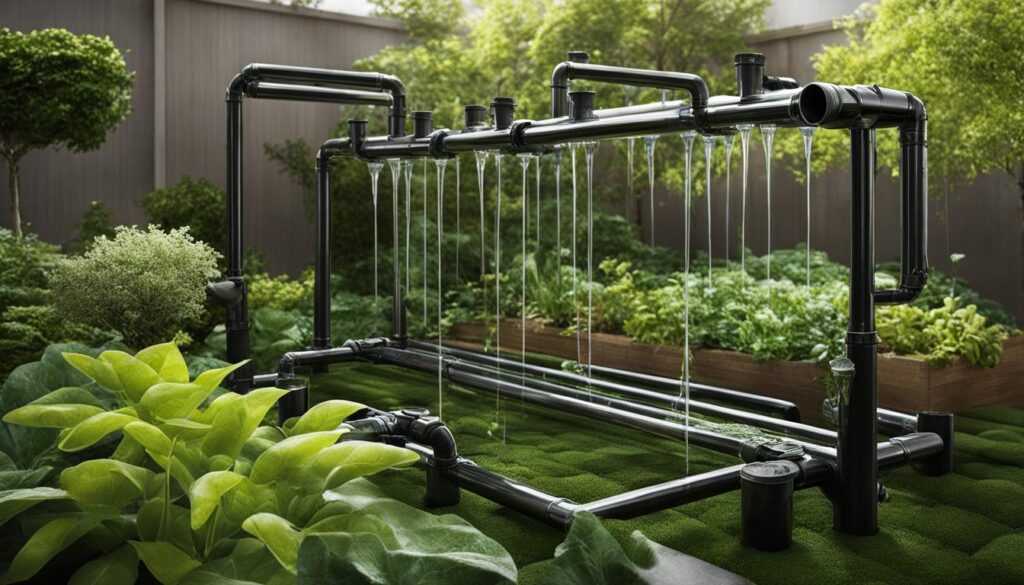
In summary, gravity-fed drip systems rely on low water pressure for efficient irrigation. By selecting the appropriate components, such as Aqua Traxx Drip Tape, 1/4″ Soaker Dripline, and Take-Apart Emitters, you can achieve effective irrigation while conserving water. Remember to optimize water pressure through elevation, dividing watering zones, or using additional water sources when necessary. With the right setup, your gravity-fed drip system will provide optimal water distribution for healthy and thriving plants.
Sprinkler to Drip Conversion
Converting your sprinkler system to a drip system is smart and eco-friendly for water-efficient landscaping. By making this conversion, you can significantly reduce water waste and ensure that your plants receive the right amount of water without overwatering. With the right tools and a little bit of effort, you can easily transition from traditional sprinklers to a more efficient drip irrigation system.
One of the main benefits of sprinkler-to-drip conversion is the water-saving potential. Drip irrigation delivers water directly to the plant’s root zone, minimizing evaporation and runoff. This targeted watering helps to conserve water resources and can result in significant water savings over time. Additionally, a drip system can provide better coverage for your garden, ensuring every plant receives the necessary moisture.
When converting your sprinkler system to drip irrigation, it’s important to assess the specific needs of your garden. Consider factors such as plant types, soil conditions, and the layout of your landscape. This will help you determine the appropriate drip emitters, tubing, and other components needed for the conversion. You may also need to adjust the water pressure or add a pressure regulator to ensure optimal performance of the drip system.
Table: Sprinkler to Drip Conversion Kit Components
| Component | Description |
|---|---|
| Drip Emitters | Small devices that release water slowly and directly to the plant’s root zone. |
| Tubing | Flexible tubes used to carry water from the main water source to the drip emitters. |
| Pressure Regulator | A device that ensures the water pressure remains consistent throughout the drip system. |
| Filter | Removes debris and other particles from the water, preventing clogging of the drip emitters. |
| Timer | Automates the watering schedule, allowing you to set specific durations and frequencies. |
| Backflow Preventer | Prevents water from flowing back into the main water supply, ensuring a safe and clean irrigation system. |
By investing in a quality sprinkler-to-drip conversion kit, you can streamline the process and ensure that you have all the necessary components for a successful conversion. These kits often come with detailed instructions, making it easier for DIY enthusiasts to handle the installation themselves. However, if you’re unsure or prefer professional assistance, it’s always a good idea to consult with an experienced landscaper or irrigation specialist.
With a sprinkler-to-drip conversion, you can enjoy the benefits of water-efficient landscaping while promoting healthier plants and a more sustainable outdoor environment. Whether you have a small garden or a large landscape, making this switch can make a significant difference in conserving water and maintaining a beautiful, thriving garden.
Conserving Water with Your Sprinkler System
Regarding water conservation, your sprinkler system can play a crucial role. By implementing a few simple strategies, you can maximize the efficiency of your system and significantly reduce water wastage. Let’s explore some tips to help you conserve water and make your sprinkler system more water-efficient.
1. Install a Rain/Freeze Sensor
One of the easiest ways to conserve water is by installing a rain/freeze sensor. This device automatically detects rainfall and freezing temperatures, preventing your sprinklers from operating during these conditions. By avoiding unnecessary watering during rain or freezing weather, you can save water and avoid overwatering your lawn and plants.
2. Use Drip Irrigation and Bubblers
Incorporating drip irrigation and bubblers into your sprinkler system is another effective way to conserve water. Drip irrigation delivers water directly to the root zone of plants, reducing evaporation and ensuring efficient water usage. Bubblers are ideal for watering specific areas, such as flower beds or shrubs, where a slower and more targeted water application is required. By replacing traditional sprinkler heads with drip irrigation and bubblers in appropriate areas, you can significantly minimize water wastage.
3. Know Your Lawn’s Water Needs
Understanding the water needs of your lawn is essential for water conservation. Different grass types have varying requirements, and weather conditions and soil types also impact irrigation needs. By determining the optimal watering schedule for your lawn and adjusting your sprinkler system accordingly, you can prevent overwatering and ensure that your lawn receives just the right amount of water.
| Grass Type | Irrigation Needs |
|---|---|
| Bermuda Grass | Drought-tolerant; requires less frequent watering |
| Fescue Grass | Requires more frequent watering and shade |
| Zoysia Grass | Moderate water needs |
Remember, it’s important to water deeply and infrequently to encourage the growth of deep roots and establish a healthier, more drought-resistant lawn.
By implementing these water-saving strategies and maintaining your sprinkler system regularly, you can make a significant positive impact on both the environment and your water bills. Conserving water with your sprinkler system not only benefits you but also contributes to the overall sustainability of water resources.
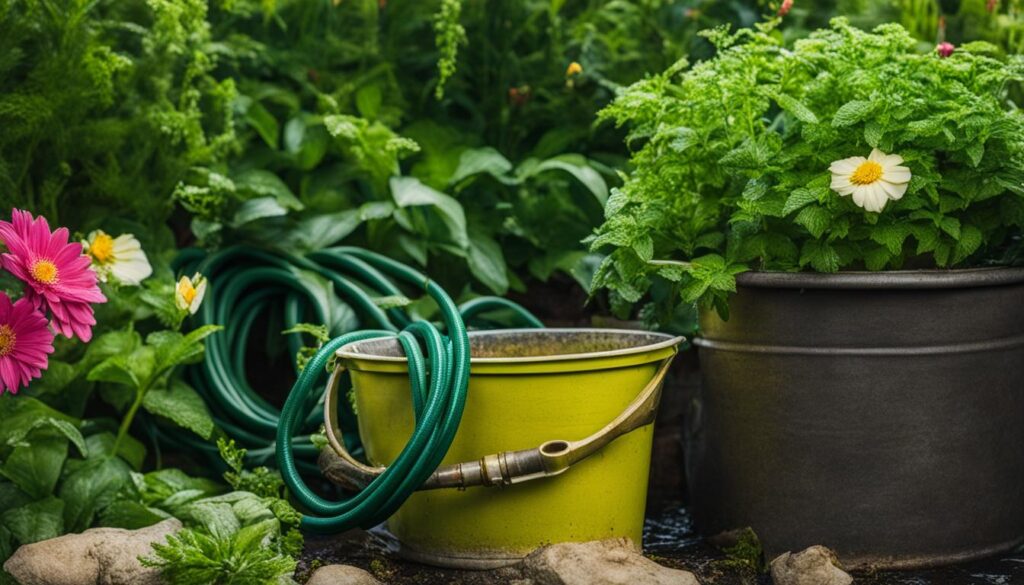
Using Rain Gauges and Hydrozones for Water Efficiency
One of the key elements in achieving water efficiency in your landscape design is utilizing rain gauges. Rain gauges serve as valuable tools in measuring rainfall and providing important data for adjusting your watering schedule. By tracking the rainfall your garden receives, you can determine if additional watering is necessary or if you can skip a watering session to conserve water. Incorporating rain gauges into your irrigation system can help you make informed decisions about when and how much to water, promoting water efficiency and preventing overwatering.
Another effective strategy for maximizing water efficiency is the creation of hydrozones in your landscape design. Hydrozones involve grouping plants with similar water requirements together in separate irrigation zones. This allows you to tailor the amount of water delivered to each zone based on the specific needs of the plants, preventing water waste and ensuring optimal growth. By dividing your garden into hydrozones, you can avoid overwatering drought-tolerant plants and provide adequate irrigation to plants that require more moisture. This targeted approach to watering ensures that each plant receives the appropriate amount of water, resulting in healthier and more vibrant vegetation.
Creating hydrozones can be done by arranging plants based on their water needs and separating them into different zones. For example, grouping plants that are native to arid regions or have low water requirements together in one zone and grouping plants that require more water or have higher moisture needs in another zone. This allows you to customize your irrigation schedule and the amount of water delivered to each zone, conserving water and promoting the overall health of your landscape.
The Benefits of Rain Gauges and Hydrozones
By incorporating rain gauges and hydrozones into your water-efficient landscape design, you can enjoy several benefits. Firstly, using rain gauges helps you optimize your watering schedule by providing accurate data on rainfall. This prevents wasteful watering and ensures that your plants receive the appropriate water. Secondly, creating hydrozones allows you to customize your irrigation system to match the water needs of different plant groups, improving overall plant health and minimizing water waste. Lastly, by implementing these strategies, you can save money on your water bills and contribute to water conservation efforts.
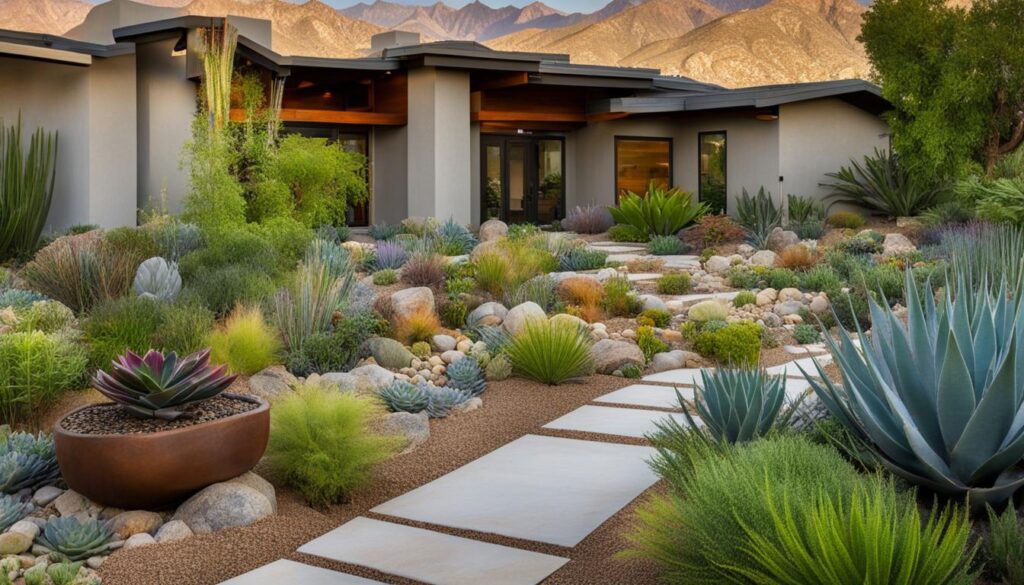
In conclusion, rain gauges and hydrozones are valuable tools for achieving water efficiency in your landscape design. By monitoring rainfall and customizing your irrigation system based on plant water needs, you can conserve water, promote plant health, and reduce water bills. Incorporating these strategies into your water-efficient landscape design not only benefits your garden but also contributes to sustainable water usage. Embrace the power of rain gauges and hydrozones and create a more efficient and environmentally-friendly irrigation system for your outdoor space.
Adjusting Sprinkler Timers and Using Rotary Nozzles
When optimizing your sprinkler system for water efficiency, two key factors are sprinkler timers and rotary nozzles. By adjusting your sprinkler timer settings and incorporating rotary nozzles into your system, you can ensure water is used more effectively and efficiently, resulting in significant water savings.
Adjusting Sprinkler Timers
An essential step in achieving a water-efficient irrigation system is adjusting your sprinkler timers based on the seasonal watering needs of your landscape. By customizing the watering schedule to match the specific requirements of your plants, you can avoid overwatering and minimize water waste.
Set the sprinkler timer to run during the early morning hours when temperatures are cooler and evaporation rates are lower. This allows water to penetrate the soil effectively and reduces the risk of water loss due to evaporation. Additionally, consider incorporating a rain sensor into your sprinkler system. Rain sensors automatically detect rainfall and temporarily suspend watering when it’s not necessary, further conserving water.
Using Rotary Nozzles
Another effective strategy for water-efficient irrigation is the use of rotary nozzles. Unlike traditional spray nozzles, rotary nozzles deliver water slowly, allowing for better absorption into the ground. This helps to minimize runoff and ensures that water reaches the root zone of plants where it is needed most.
Rotary nozzles also provide more uniform coverage, reducing the potential for dry spots or oversaturation. By distributing water evenly, they help to optimize water usage and promote healthier plant growth. Consider replacing existing spray nozzles with rotary nozzles in areas where water efficiency is crucial, such as flower beds, shrubbery, or other landscape features.
| Benefits of Adjusting Sprinkler Timers and Using Rotary Nozzles | Benefits of Adjusting Sprinkler Timers and Using Rotary Nozzles |
|---|---|
| Reduces water waste by avoiding overwatering | Promotes healthier plant growth and reduces the risk of water-related diseases |
| Minimizes runoff and ensures water reaches the root zone | Conserves water resources and reduces water bills |
| Improves irrigation efficiency and reduces maintenance needs | Enhances the overall appearance of your landscape |
By adjusting sprinkler timers and incorporating rotary nozzles, you can achieve a more water-efficient irrigation system that not only saves water but also promotes healthier and more vibrant landscapes. These simple yet effective measures make a significant difference in preserving our precious water resources and reducing water bills. Take the initiative today to optimize your sprinkler system and contribute to a more sustainable future.
Conclusion
In conclusion, adding a drip irrigation system to your existing sprinkler system is a smart DIY project that can result in significant water savings and numerous benefits for your lawn and garden. By incorporating drip irrigation, you can effectively conserve water, reduce your water bills, and promote the health and vitality of your plants.
Implementing a DIY drip irrigation system is a rewarding endeavour that allows you to customize your irrigation to suit your specific needs. With the right tools and knowledge, you can easily install and maintain a drip system that efficiently delivers water directly to the root zones of your plants, minimizing wastage and ensuring they receive the right amount of water.
By embracing the DIY spirit and adopting water-saving tips like drip irrigation, you can play a part in conserving water resources and creating a more sustainable landscape. Regular maintenance and adjustments to your irrigation system, along with thoughtful choices like grouping plants with similar needs, will help you achieve a water-efficient garden that thrives while minimizing environmental impact.
James Dunnington leads the James Dunnington Collection, featuring five unique blogs: a practical Pet Care Guide, an enlightening Ancient History Blog, a resourceful Home Improvement Guide, a cutting-edge Tech Innovation Guide, and a strategic Online Money Making platform. Each site delivers valuable insights designed to empower and inform. For updates and more tips, visit our Contact Us page to sign up for our newsletter, ensuring you never miss out on the latest content from any of these dynamic fields.
